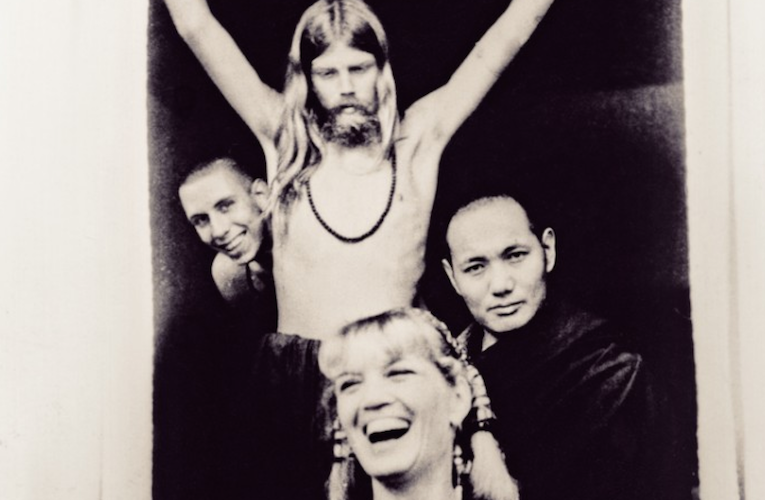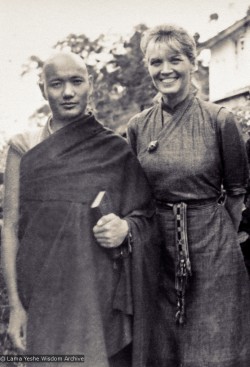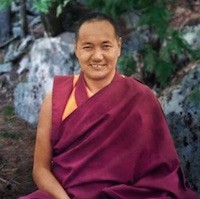
After Lama Thubten Yeshe gave a lecture in 1975, he answered questions from the students in attendance.
The preceding talk can be found here.
Q. What’s the best way to attain enlightenment oneself? Where does one find enlightenment?
Lama: By dealing with your own mind. By knowing your own mind’s nature. That’s the best thing. Otherwise, you just collect ideas; too many ideas—“This idea; this religion; this religious idea.” All you do is collect ideas, but you have no understanding of how they relate to your own mind. Thus, you end up with nothingness.
The best thing, the real solution to your own problems, is to face them; to try to understand their nature. If you can do that, problems disappear by themselves. You can discover this through your own personal experience. If you read books containing fantastic ideas, religions and philosophies but don’t know how to put those ideas into action, if you don’t have the key, the ideas themselves become problems. The best thing you can do is to try to understand your own nature. That’s better than trying to find out more about me, for example: “What is this lama?” It’s impossible to stop problems that way.
But by constantly observing your own everyday life—how your mind interprets your family and friends, how your mind interprets what you feel—by always checking, you will realize that what makes life complicated is your own misconceptions. You will understand that your problems come from you. Now you are starting to learn. The more you understand, the more progress you make, the closer you get to liberation. There’s no progress without understanding. That’s why Lord Buddha said, all you have to do is understand; then you’ll progress along the path. If you have no understanding, even if you learn countless intellectual ideas, they’re just ideas; you’re wasting your life.
Q. It seems that to achieve the desired result from meditation, you need a certain kind of environment. What are the implications of this fact for those of us who live in a concrete, noisy, nine-to-five world with little or no contact with others interested in the spiritual path. Do you believe that psychedelics like LSD can be important or useful for people like this?
Lama: Well, it’s hard to say. I’ve never taken anything like that. But Buddhist teachings do talk about how material substances affect the human nervous system and the relationship between the nervous system and the mind. We study this kind of thing in Buddhist philosophy. From what I’ve learned, I would say that taking drugs goes against what Buddhism recommends.
However, my own point of view is that people who are completely preoccupied with the sense world, who have no idea of the possibilities of mental development, can possibly benefit from the drug experience. How? If people whose reality is limited to the meat and bone of this human body have this experience, perhaps they’ll think, “Wow! I thought this physical world was all there is, but now I can see that it’s possible for my mind to develop beyond the constraints of my flesh and blood body.” In some cases the drug experience can open up a person’s mind to the possibility of mental development. But once you’ve had that experience, it’s wrong to keep taking hallucinogens because the drug experience is not real understanding; it’s not a proper realization. The mind is still limited because matter itself is so limited; it’s up and down, up and down. Also, if you take too many drugs you can damage your brain. So, that’s just my personal point of view.
Q. Do I need anything?
Lama: I hope you need something. No, you definitely need something. But it’s for you to check up what you need. Your needs come from within you, not from without. Still, many times we say, “I need this, I need that,” and throughout our lives accumulate so much stuff. But when we really check up the why and the how of our needs, we can finish up finding that we need almost nothing.
Q. Are you saying that Western education is a waste of time?
Lama: No, that’s not what I’m saying. It depends on the individual; it depends on how you learn, not the education itself. How you learn is what’s important.

Q. Could you explain again how we find answers from within ourselves.
Lama: Let your obsessed sense perception rest for a while and allow your silent mind to surface. Then ask your question. You will find that the answer to your question will appear spontaneously from within the peaceful stillness of your silent mind.
Q. Are you saying that we have to enlighten ourselves?
Lama: Yes, that’s exactly what I’m saying.
Q. Then why do we need to follow a teacher?
Lama: We need somebody to teach us how to find the answers from within ourselves; how to put our energy into the right channel so that the right answers appear. Most of the time, the answer is here but we’re looking for it over there, in completely the opposite direction.
Q. What does Tibetan Buddhism have that other branches of Buddhism do not?
Lama: First, I would say that all branches of Buddhism are teaching fundamentally the same thing—an approach to developing the human mind. But individually, we think, “I’m Christian, I’m Jewish, I’m this religion, I’m that,” but we actually have no idea of how to put our religion into action; we don’t know the method. However, that is completely up to the individual. Also, Tibetan Buddhism doesn’t contradict the other schools—Zen, Hinayana and so forth. Basically, they are all the same. Of course, we see things from only the outside, so our judgments are very superficial. We ask someone, “What’s your religion?” He says, “I’m this….” Then we check to see if the person’s happy or not. If we think he’s unhappy, we go, “Oh, he’s unhappy; that religion must be horrible.” Our value judgments are so limited. We should be careful not to do this. For example, tonight I have spoken about many things. If tomorrow someone asks you, “What do you really feel about what Lama said last night?” be careful not to reply as if yours is the definitive view. Everybody here will have a different opinion. We interpret things through our limited point of view, so it can be dangerous to say categorically, “This religion is that; that religion is this.”
*Read more from Lama Yeshe’s The Peaceful Stillness of the Silent Mind, a series of lectures given in Australia in 1975. Edited by Nicholas Ribush. Freely available from the Lama Yeshe Wisdom Archive.
Relephant:
A Glimpse of Buddhist Psychology. ~ Lama Thubten Yeshe
~
Author: Lama Yeshe
Editor: Travis May
Photo: Author’s Own











Read 3 comments and reply